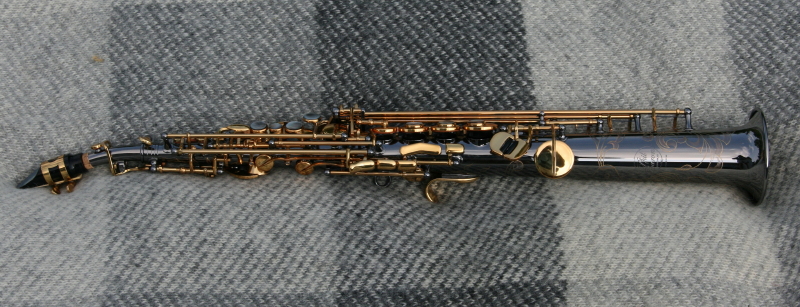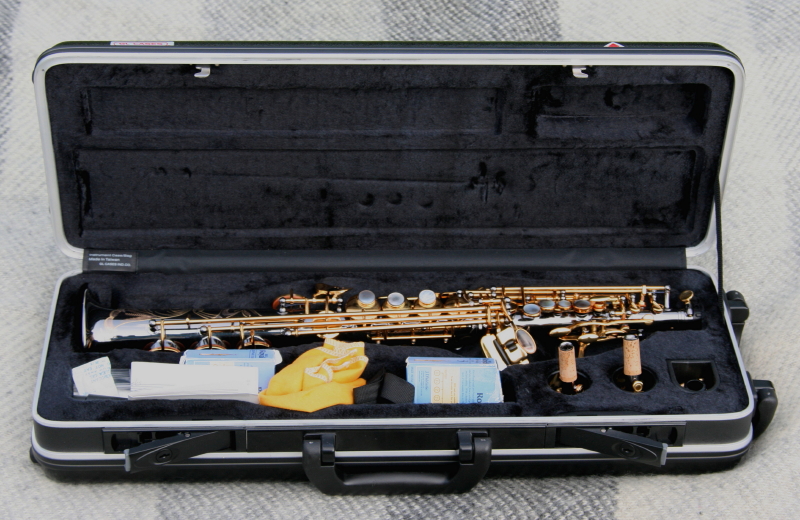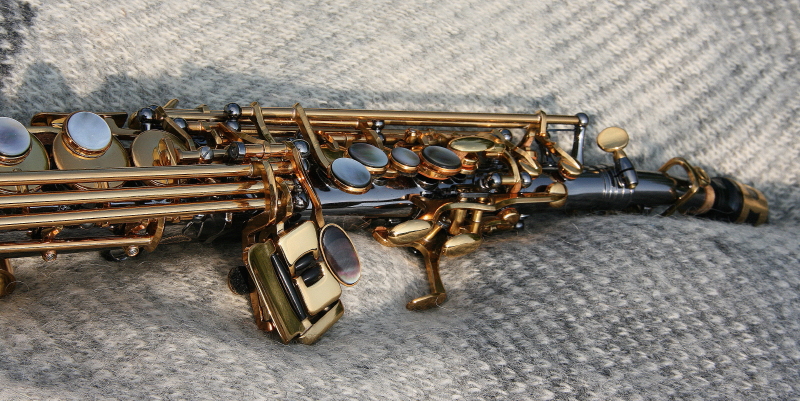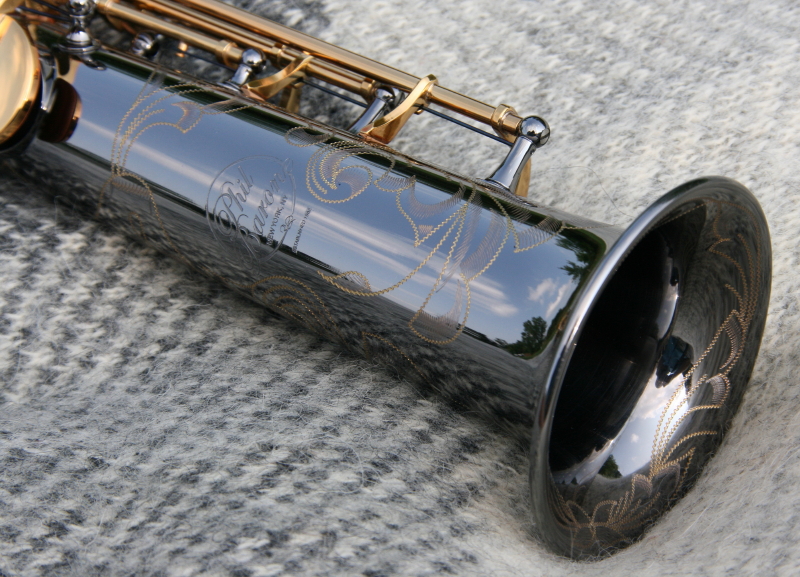
I. LOVE. My new Phil Barone soprano saxophone!
I mean, I seriously dig this horn.
When I sold my vintage Yamaha YSS 62 “Purple Label” a couple years ago, I went into a period of minor mourning. But the tax man required money, and for as long as I had owned the horn–since the mid 1980s–I hadn’t played it much. Practicality won out; the sax went on eBay and got snapped up.
I doubted I’d ever be able to afford another soprano sax of its quality, even used.
The loss became more apparent as the band I play in, My Thin Place (MTP), has prioritized ECM-style tunes that call for the soprano sound. I’m primarily an alto man, and MTP plays plenty of tunes for which alto is the right voice. But when it comes to our originals and numbers like Oregon’s “1,000 Kilometers” and John Abercrombie’s “Timeless,” the soprano is the better fit–in some cases, the only fit. So now what?
Enter–and huge thanks to–my friend and fellow saxophonist Michael Doyle (Evidence; Big Band Nouveau). Recognizing my need to supply the appropriate voice for MTP, he volunteered his Mark VI. “Hang onto it,” he told me. “Just get it to me when I need it.” That was way beyond gracious of Mike, and it was our arrangement for a year or more.
But realistically, I needed a horn of my own. I just didn’t have the money. Self-employment as an editor and writer is a roller coaster, and when the checks come in, they’re usually spoken for. When I felt I could responsibly purchase another horn, I would do so. But that time wasn’t now, and I didn’t know when it would be.
A NAMELESS BENEFACTOR AND A GENEROUS GIFT
Then one evening, at my monthly Sandy Point Beach House gig with MTP, my friend Dave DeVos, the bassist and band leader, told me, “Someone wants to buy you a soprano saxophone. They prefer to remain unknown. How much would a new horn cost?”
Well, that was a question I hadn’t considered lately.
A nameless benefactor wanted to buy me a horn? Really?
Yes, said Dave. West Michigan has its share of arts patrons, and he had approached one of them on my behalf. So, how much?
Whoever it was that was being so gracious toward me, I didn’t want to overreach on his or her generosity. I named an amount: two thousand dollars–hesitantly, because it seemed like an awful lot of money. It was an awful lot of money. But in the world of saxophones, I believed it was practical yet conservative. Then I started shopping online.
A QUEST FOR VALUE
Ouch! Man, those little stinkers are pricey! Had I underestimated? True, you can buy a Chinese horn for a couple hundred bucks, but do you really want to hang your sound on such an instrument, particularly when it’s going to play a defining role in the band?
Two grand, on the other hand, ought to buy me something decent. Maybe not in the same league as the vintage Yamaha I had parted with, but certainly a good horn of a quality one could count on. I just needed to ask the Lord to guide me to it, and I needed to do my homework.
So I dug more deeply. And I began to read glowing accounts of Phil Barone saxophones. Phil, a professional saxophonist in New York, aims to provide pro-quality saxophones at an affordable price for guys like me who can’t afford to slap down $4,000 or more for a new Yamaha, Selmer, Cannonball, or Yanigasawa. By skipping the retailers and selling direct to consumer, Phil is able to offer his saxophones at substantial savings. His website says, “When you order a Phil Barone saxophone, you’re ordering direct from the maker, who doesn’t spend a lot of money or time on expensive ad campaigns or marketing. Great reviews and word of mouth works just fine for Phil Barone. The result is a professional quality saxophone priced for the student; an instrument that doesn’t just rival the sound of more expensive brands but out-plays them time and time again.”
All fine and well–but really? Were the horns as good as all that?
Based on what I read on Sax on the Web and elsewhere, player after player seemed to think so. The reviews weren’t merely positive–they were consistently rave. Saxophonists were loving these horns, preferring them even over their Yamahas and Selmers. I checked out some YouTube demonstrations and was impressed. The intonation–an obvious concern with soprano saxophones–was good, and the sound seemed clear and consistent.
Given a reasonable trial period, what did I have to lose? I ordered a nickel-plated model and eagerly awaited its arrival.

A DELIGHT TO LOOK AT, A JOY TO PLAY
I was in the throes of a terrible cold when the saxophone arrived, so I wasn’t in shape to take it for a test flight immediately. I was barely up to feeling excited–but excited I was, nevertheless. I unboxed the new arrival and, with some trepidation about what I would find, opened the sturdy black hardshell case.
The horn was gorgeous.
It was also well packaged, with pads and keys clamped snugly and all separate pieces wrapped in plastic. Those included, besides the main saxophone body, both a curved and a straight neck, a neckstrap, my choice of one of Phil’s $200 mouthpieces (included in the purchase price), and a basic ligature.
Removing the plastic, I inspected the instrument visually. The finish was flawless–not a rough patch or defect anywhere that I could see. Just sumptuous gold engraving against a smooth, silvery dark nickel lacquer on a sturdily built instrument. My gosh. If this horn’s sound and performance matched its appearance, then I had just gotten a very sweet deal indeed. I’d have to wait to find out, because physically I just wasn’t up to playing a wind instrument. But so far, visually, this soprano had just taken my breath away.
By the next afternoon I had crossed the hump with the cold, and I could wait no longer. I had to know. Grabbing the new soprano, I headed out to Charlton Park east of town–a riverside location where I love to practice–and I assembled the horn and blew my first notes.
Forty-five minutes later I was on the phone with Phil Barone. I wanted to tell him personally how delighted I was and thank him for making such a marvelous instrument accessible to me.
FOUR MONTHS LATER
That was back in late April. It is now mid August. Having had some time to familiarize myself with this saxophone, I can tell you that I no longer feel the loss of my vintage YSS 62. That was a wonderful soprano saxophone, but this new horn surpasses it. It is everything its maker claims. Its lovely tone is consistent throughout the range of the instrument; it is solidly built, with intuitive ergonomics that allow my fingers to fall naturally in place; it is responsive, mechanically deft, and has excellent intonation. It most certainly plays as beautifully as it looks–and that is saying a mouthful. I am proud to own this horn and very grateful to the person who saw fit to bless me with it.
The new Barone is inspiring me to do something I never did with my old Yamaha: spend serious time practicing the soprano sax, learning its nuances and getting a feel for my sound on it. I’ve come to appreciate how very different in temperament it is from my alto saxophone. My Conn 6M alto is a golden-toned, swashbuckling, exuberant instrument that will take as much air as I can give it, and it resonates in my hands like a living thing. This soprano is a lady with a soft, pretty voice, and she’s at her best when I treat her as such.
Due to its smaller size, the soprano is a more temperamental instrument than the alto and tenor saxophones, and intonation can go out of whack in a hurry. Using new, crisp reeds makes a world of difference for playing in tune, and getting the right mouthpiece/reed setup is crucial. The Barone 7* vintage mouthpiece that came with the horn proved to be too ambitious for me. That was my fault. Barone mouthpieces receive stellar reviews, and this one is what I ordered. But in my ignorance about the soprano, I overestimated what I needed; a smaller tip opening would have served me better. I have yet to try using a softer reed–a #2, possibly even a #1 1/2. I’m not a fan of soft reeds, but I’m still in the learning curve with the new soprano and am game to try different options.
My present mouthpiece/reed setup pairs a considerably more moderate Yamaha 4C mouthpiece with a Rico Royal #3 reed. The sound I get with this combination is clear and consistent, and the intonation is great throughout the range of the horn. Still, it will take some time before I feel confident about what setup I want to settle into. The close tip opening of the 4C is at the opposite end of the spectrum from the wide-open Barone 7*, and I’d like to be able to move a little more air. A half-size stronger reed might be the solution. As well, given the affordability of Yamaha mouthpieces–around thirty bucks a pop–I plan to pick up a 5C and see how it performs. I’ll also replace the cheap ligature with something more refined. And at some point, I’ll make a pilgrimage to one of the saxophone shops in Detroit or Chicago and spend an afternoon trying out pieces. For now, though, the 4C is working well, wonderfully so for the price.
My old Yamaha was a solid-body straight soprano. The new two-piece Barone gives me the option of using either a straight or a curved neck, depending on my mood. I’ve gravitated toward the curved neck. It puts the horn in a more comfortable position . . . which makes it more enjoyable to play . . . which means I practice it more. Indeed, I’ve become a junkie. My beloved Conn 6M alto is probably feeling neglected lately, because the Barone soprano is such a pleasure to play. Moreover, based on the comments I’ve gotten from the guys in the band, it is turning out to be a superb voice for our unit.

GENEROSITY
I wouldn’t own this marvel of a horn were it not for the generosity of three people. One of them I know; one of them I have a feel for; and one of them is a mystery.
To Dave DeVos: Thank you for seeing my need for a soprano of my own, thinking of a solution that never would have occurred to me, and inquiring on my behalf.
To Phil Barone: Thanks for putting such a superb brand-new instrument in my hands at so affordable a price.
Last, but by no means least, to my Unknown Benefactor: Thank you for donating the purchase price of this horn. You sounded no horn of your own in doing so. You just quietly made my world a better place. I hope you’re one who sits often among those who enjoy My Thin Place, and when you hear the soprano, I hope it makes you smile.
In addition–Mike Doyle, thanks so much for generously volunteering the use of your Selmer Mark VI soprano, no strings attached, during the time when I was without. I call that exceptional of you.
Generosity is a beautiful thing, particularly in a culture so focused on self and on getting. In my own life, I’ve found that God rewards generous deeds in the oddest, timeliest, and sometimes most striking ways. I’ve never put stock in the so-called “prosperity gospel”; I don’t believe faith is about sticking a buck in the vending machine and getting ten bucks back. But I do believe “God loves a cheerful giver.” Generosity is in proportion to one’s means, and one of its earmarks is the satisfaction, even the joy, that a generous act releases in the heart of the giver. It’s about the motive. Generosity is its own reward. And yet, God takes it further and honors it in unexpected, practical ways.
Mike, Dave, Phil, and my Anonymous Benefactor: May the Lord honor each of you for your generosity.
SUMMING IT UP
Phil Barone soprano saxophones provide tremendous bang for the buck, even twice the buck. It’s safe to assume the same is true of Barone alto and tenor saxes. If you’re in the market for a new saxophone, you’ll do yourself a great service by looking into Phil Barone horns. Read the reviews. They’re impressive and they’re trustworthy. This post is my own unsolicited and unpaid review, and it’s my pleasure to write it. Phil came across to me as a brisk, down-to-business guy; he isn’t a talker on the phone. But his horns do his talking for him. If you buy one, I’m confident that you, like me, will be delighted.


